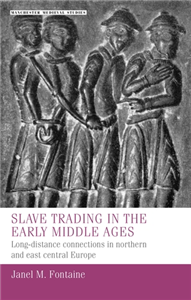Slave trading in the Early Middle Ages
Long-distance connections in northern and east central Europe
by Janel M. Fontaine
Description
More Information
Rights Information
Albania, Algeria, Angola, Argentina, Armenia, Australia, Austria, Bahrain, Belgium, Belize, Benin, Bolivia, Bosnia and Herzegovina, Botswana, Brazil, Bulgaria, Burkina Faso, Burundi, Cameroon, Canada, Cape Verde, Central African Republic, Chad, Chile, China, Colombia, Comoros, Congo [DRC], Congo, Republic of the, Costa Rica, Ivory Coast, Croatia, Czech Republic, Denmark, Djibouti, Ecuador, Egypt, El Salvador, Equatorial Guinea, Eritrea, Estonia, Ethiopia, Faroe Islands, Finland, France, French Guiana, Gabon, Gambia, Georgia, Germany, Ghana, Greece, Guatemala, Guinea, Guinea-Bissau, Guyana, Honduras, Hongkong, Hungary, Iceland, India, Indonesia, Iran, Iraq, Ireland, Israel, Italy, Japan, Jordan, Kazakhstan, Kenya, Kuwait, Latvia, Lebanon, Lesotho, Liberia, Libya, Lithuania, Luxembourg, Macau, China, Macedonia [FYROM], Madagascar, Malawi, Malaysia, Mali, Malta, Mauritania, Mauritius, Mayotte, Mexico, Mongolia, Montenegro, Morocco, Mozambique, Namibia, Netherlands, New Zealand, Nicaragua, Niger, Nigeria, Norway, Oman, Pakistan, Panama, Paraguay, Peru, Philippines, Poland, Portugal, Puerto Rico, Qatar, Reunion, Romania, Russia, Rwanda, Saint Helena, Sao Tome and Principe, Saudi Arabia, Senegal, Serbia, Seychelles, Sierra Leone, Singapore, Slovakia, Slovenia, Somalia, South Africa, South Korea, Spain, Sri Lanka, Sudan, Suriname, Swaziland, Sweden, Switzerland, Syria, Taiwan, Tanzania, Thailand, Timor-Leste, Togo, Tokelau, Tunisia, Turkey, Uganda, Ukraine, United Arab Emirates, United Kingdom, United States, Uruguay, Venezuela, Vietnam, Western Sahara, Yemen, Zambia, Zimbabwe, South Sudan, Cyprus, Palestine, Bangladesh, Cambodia, Liechtenstein, Azerbaijan, Jamaica, Kyrgyzstan, Dominican Republic, Myanmar, Monaco
Endorsements
This book reexamines slave trading in the early Middle Ages from a comparative perspective, situating it at the core of economic and political development in northern and eastern Europe. In focusing on the 'slaving zones' centred around the British Isles and the Czech lands, Fontaine traces the forced migration of enslaved people from the point of capture to their destinations across Europe, the North Atlantic, North Africa, and western Asia. The crux of the book are the changes of the ninth and tenth centuries prompted by increased demand, principally in the Islamic world as well as areas of Viking settlement. The desire to source more and more slaves led to changes in the practice of warfare to maximise captive taking, the logistics of slave trading and rulers' legal and economic relationships with slavery. By spanning the seventh through the eleventh centuries, this important study traces the growth, climax, and decline of slave trading in the early Middle Ages and establishes its role as a driver of connectivity.
Reviews
This book reexamines slave trading in the early Middle Ages from a comparative perspective, situating it at the core of economic and political development in northern and eastern Europe. In focusing on the 'slaving zones' centred around the British Isles and the Czech lands, Fontaine traces the forced migration of enslaved people from the point of capture to their destinations across Europe, the North Atlantic, North Africa, and western Asia. The crux of the book are the changes of the ninth and tenth centuries prompted by increased demand, principally in the Islamic world as well as areas of Viking settlement. The desire to source more and more slaves led to changes in the practice of warfare to maximise captive taking, the logistics of slave trading and rulers' legal and economic relationships with slavery. By spanning the seventh through the eleventh centuries, this important study traces the growth, climax, and decline of slave trading in the early Middle Ages and establishes its role as a driver of connectivity.
Author Biography
Janel M. Fontaine is an archaeologist in the public sector and an Affiliate Researcher at the University of Glasgow.
Manchester University Press
Manchester University Press is a leading UK publisher known for excellent research in the humanities and social sciences.
View all titlesBibliographic Information
- Publisher Manchester University Press
- Publication Date February 2025
- Orginal LanguageEnglish
- ISBN/Identifier 9781526160096 / 1526160099
- Publication Country or regionUnited Kingdom
- FormatPrint PDF
- Pages296
- ReadershipGeneral/trade
- Publish StatusPublished
- Dimensions216 X 138 mm
- Biblio NotesDerived from Proprietary 5467
- SeriesManchester Medieval Studies
- Reference Code14222
Manchester University Press has chosen to review this offer before it proceeds.
You will receive an email update that will bring you back to complete the process.
You can also check the status in the My Offers area

Please wait while the payment is being prepared.
Do not close this window.



